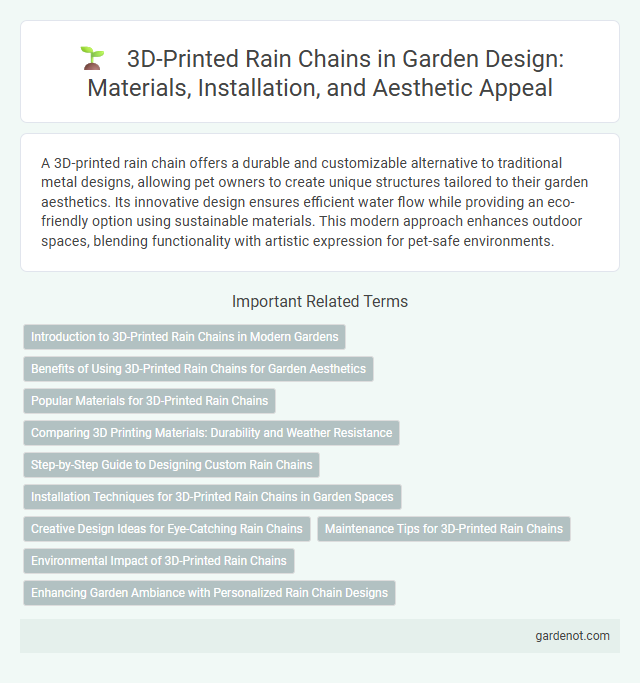A 3D-printed rain chain offers a durable and customizable alternative to traditional metal designs, allowing pet owners to create unique structures tailored to their garden aesthetics. Its innovative design ensures efficient water flow while providing an eco-friendly option using sustainable materials. This modern approach enhances outdoor spaces, blending functionality with artistic expression for pet-safe environments.
Introduction to 3D-Printed Rain Chains in Modern Gardens
3D-printed rain chains revolutionize traditional garden drainage by combining aesthetic appeal with customized design tailored to specific landscapes. Utilizing durable, eco-friendly materials, these rain chains effectively guide water flow while serving as unique sculptural elements in modern gardens. Advanced 3D printing technology enables intricate patterns and shapes, enhancing both functionality and artistic expression in outdoor spaces.
Benefits of Using 3D-Printed Rain Chains for Garden Aesthetics
3D-printed rain chains offer customizable designs that enhance garden aesthetics by seamlessly blending functionality with artistic expression. The precision of 3D printing allows for intricate geometric patterns and personalized motifs that traditional metal or bamboo chains cannot replicate. Durable, lightweight materials used in 3D printing ensure longevity while maintaining a visually appealing flow of water, making the garden space both practical and visually captivating.
Popular Materials for 3D-Printed Rain Chains
Popular materials for 3D-printed rain chains include PLA, ABS, and PETG due to their durability and weather resistance. PLA offers ease of printing and vibrant color options but is less heat-resistant compared to ABS, which provides greater toughness and UV stability. PETG combines flexibility with strong water resistance, making it an ideal choice for outdoor rain chain applications.
Comparing 3D Printing Materials: Durability and Weather Resistance
3D-printed rain chains benefit from materials like PLA, ABS, and PETG, each offering distinct durability and weather resistance. PETG stands out for its superior UV and moisture resistance, maintaining structural integrity longer in outdoor conditions compared to PLA, which is biodegradable but less weather-resistant. ABS provides good impact resistance and heat tolerance but may degrade under prolonged sun exposure, making PETG the preferred choice for long-lasting, weather-resistant 3D-printed rain chains.
Step-by-Step Guide to Designing Custom Rain Chains
Designing custom 3D-printed rain chains involves selecting durable, weather-resistant materials such as PLA or PETG to ensure longevity and functionality. Start by modeling interlocking link components with drainage holes in CAD software, optimizing for water flow and aesthetic appeal. Iterative prototyping with 3D printing allows for precise adjustments, resulting in a personalized rain chain that seamlessly combines form and function.
Installation Techniques for 3D-Printed Rain Chains in Garden Spaces
Installation techniques for 3D-printed rain chains in garden spaces emphasize secure attachment to gutters using custom-designed hooks or brackets tailored to the chain's unique geometry. Proper alignment ensures efficient water flow, minimizing splashing and erosion around garden beds. Utilizing corrosion-resistant materials and UV-stabilized filaments enhances durability, making the rain chain both a functional and decorative element in landscaping.
Creative Design Ideas for Eye-Catching Rain Chains
3D-printed rain chains offer unique opportunities for creative design, allowing for intricate patterns and customized shapes that traditional materials cannot easily achieve. Designers can incorporate geometric forms, nature-inspired motifs, or abstract artistic elements to create eye-catching rain chains that complement modern architecture and garden aesthetics. The precision of 3D printing enables functional art pieces that effectively channel water while serving as striking visual focal points.
Maintenance Tips for 3D-Printed Rain Chains
3D-printed rain chains require regular cleaning to prevent clogging from leaves and debris, ensuring optimal water flow and longevity. Use a soft brush or cloth to gently remove dirt without scratching the printed surface, and avoid harsh chemicals that may damage the filament material. Inspect the rain chain periodically for cracks or wear, especially in outdoor conditions where UV exposure and moisture can degrade certain 3D printing materials.
Environmental Impact of 3D-Printed Rain Chains
3D-printed rain chains reduce environmental impact by utilizing biodegradable or recycled filaments, minimizing plastic waste compared to traditional materials like metal or ceramic. The precise manufacturing process of 3D printing decreases material waste and energy consumption, promoting sustainable production methods. Furthermore, lightweight 3D-printed rain chains lower transportation emissions due to reduced shipping weight.
Enhancing Garden Ambiance with Personalized Rain Chain Designs
3D-printed rain chains offer bespoke designs that elevate garden aesthetics by seamlessly combining functionality with artistry. Customized patterns and shapes enhance water flow visibility while adding unique visual interest and charm. This innovative approach allows gardeners to create personalized rain chains that complement landscape themes and improve outdoor ambiance.
3D-printed rain chain Infographic

 gardenot.com
gardenot.com